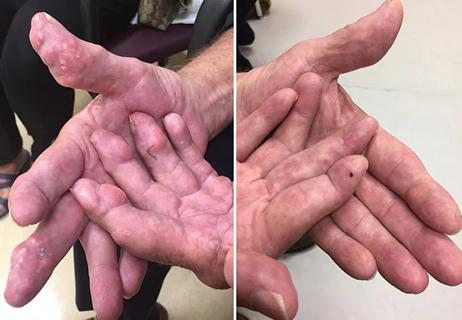Increased exposure to steroids may be another driver of increased morbidity and mortality in this population

By James K Sullivan, BA, and Emily A Littlejohn, DO, MPH
Advertisement
Cleveland Clinic is a non-profit academic medical center. Advertising on our site helps support our mission. We do not endorse non-Cleveland Clinic products or services. Policy
After adjusting for validated measures of systemic lupus erythematosus (SLE) disease activity, recent hospitalization, disability and SLE medications used (hydroxychloroquine and cDMARD), Black participants were more than 5 times more likely to use chronic glucocorticoids for management of SLE, according to unpublished data analysis conducted at Cleveland Clinic. In addition to increased risk of adverse outcomes specific to SLE disease activity, these data indicate Black patients may face increased morbidity and mortality from chronic steroid use.
SLE is a multisystem inflammatory autoimmune syndrome with higher morbidity and mortality rates than many other major rheumatologic conditions.1,2 Significant racial disparities exist in SLE incidence, long-term outcomes and mortality. In particular, Black patients with SLE have up to four-fold greater SLE-related mortality,3 three-fold higher incidence of end-stage renal disease4 and higher incidence of cardiovascular and neuropsychiatric SLE manifestation5 compared with white patients with SLE. Given these trends, recent research has sought to identify modifiable factors related to the medical management of SLE that underlie these disparities. While glucocorticoids are a potent therapeutic to ameliorate acute SLE flares, chronic long-term use has been associated with poor health outcomes, particularly among those with minimal SLE disease activity.6
We sought to quantify chronic glucocorticoid use among Black and white patients with systemic lupus erythematosus (SLE) within a prospective registry run at Cleveland Clinic. We conducted multivariable logistic regression of race and glucocorticoid use, adjusting for covariates exhibiting a bivariate association with glucocorticoids at a significance level of P < 0.10.
Advertisement
We analyzed data from 114 white participants (mean age 45; standard deviation [SD] 15) and 59 Black participants (mean age 42; SD 14). White participants had a mean score of 3.7 (SD 5.2) on the Systemic Lupus Erythematosus Disease Activity Index 2000 (SLEDAI-2K). Black participants had a mean SLEDAI-2K score of 6.3 (SD 6.0). Among Black participants, 43 (72%) utilized glucocorticoids compared with white participants 39 (34%) (unadjusted odds ratio [OR] 5.17; 95% confidence interval [CI] 2.59-10.33). We did not observe differences between unadjusted hydroxychloroquine (OR 0.69; 95% CI 0.28-1.65) or conventional disease-modifying anti-rheumatic drug (cDMARD) (OR 1.07; 95% CI 0.57-2.01) utilization among Black and white participants. SLEDAI-2K, disability, recent hospitalization and past or present hydroxychloroquine or cDMARD use were included in a logistic regression model. Adjusting for covariates, Black participants were more likely to be on glucocorticoids (adjusted OR 5.69; 95% CI 2.17-14.96; P = 0.0004).
| Medication | White (N = 114) | Black (N = 59) | P value* | Odds ratio (95% confidence interval) |
|---|---|---|---|---|
| Chronic corticosteroids (oral or intravenous) | 39 (34%) | 43 (73%) | < 0.0001 | 5.17 (2.59-10.33) |
| NSAIDs† | 35 (31%) | 20 (34%) | 0.62 | 1.19 (0.51-2.33) |
| Hydroxychloroquine | 100 (88%) | 49 (83%) | 0.40 | 0.69 (0.2581.65) |
| Conventional DMARDsठ| 58 (51%) | 31 (53%) | 0.84 | 1.07 (0.57-2.01) |
| Biological DMARDs¶ | 8 (7%) | 3 (%%) | 0.75# | 0.71 (0.18-2.78) |
| Medication | ||||
| Chronic corticosteroids (oral or intravenous) | ||||
| White (N = 114) | ||||
| 39 (34%) | ||||
| Black (N = 59) | ||||
| 43 (73%) | ||||
| P value* | ||||
| < 0.0001 | ||||
| Odds ratio (95% confidence interval) | ||||
| 5.17 (2.59-10.33) | ||||
| NSAIDs† | ||||
| White (N = 114) | ||||
| 35 (31%) | ||||
| Black (N = 59) | ||||
| 20 (34%) | ||||
| P value* | ||||
| 0.62 | ||||
| Odds ratio (95% confidence interval) | ||||
| 1.19 (0.51-2.33) | ||||
| Hydroxychloroquine | ||||
| White (N = 114) | ||||
| 100 (88%) | ||||
| Black (N = 59) | ||||
| 49 (83%) | ||||
| P value* | ||||
| 0.40 | ||||
| Odds ratio (95% confidence interval) | ||||
| 0.69 (0.2581.65) | ||||
| Conventional DMARDsठ| ||||
| White (N = 114) | ||||
| 58 (51%) | ||||
| Black (N = 59) | ||||
| 31 (53%) | ||||
| P value* | ||||
| 0.84 | ||||
| Odds ratio (95% confidence interval) | ||||
| 1.07 (0.57-2.01) | ||||
| Biological DMARDs¶ | ||||
| White (N = 114) | ||||
| 8 (7%) | ||||
| Black (N = 59) | ||||
| 3 (%%) | ||||
| P value* | ||||
| 0.75# | ||||
| Odds ratio (95% confidence interval) | ||||
| 0.71 (0.18-2.78) |
*All statistical tests performed utilized Pearson’s Chi Squared Test except where indicated
† NSAIDs stands for non-steroidal anti-inflammatory drugs
‡DMARD stands for disease-modifying anti-rheumatic drug
§ Conventional DMARDs consist of methotrexate, azathioprine, mycophenolate, leflunomide, cyclophosphamide
¶ Biologic DMARDs consist of rituximab, belimumab
# Fischer’s Exact Test
| Variable | Estimate | Odds Ratio(95% confidenceinterval) | P Value |
|---|---|---|---|
| Intercept | -2.51 | < 0.0001 | |
| Race (Black) | 1.74 | 5.69 (2.17-14.96) | 0.0004 |
| Hospitalization | -0.52 | 0.60 (0.21-1.69) | 0.33 |
| Total SLEDAI-2K* ≥ 6 | 1.73 | 5.66 (1.93-1656) | 0.002 |
| Disabled | 1.34 | 3.81 (1.45-10.17) | 0.007 |
| Never used hydroxychloroquine | 1.24 | 3.44 (0.59-19.33) | 0.17 |
| Ever used cDMARD† | 1.75 | 5.76 (2.20-15.04) | 0.0004 |
| Variable | |||
| Intercept | |||
| Estimate | |||
| -2.51 | |||
| Odds Ratio(95% confidenceinterval) | |||
| P Value | |||
| < 0.0001 | |||
| Race (Black) | |||
| Estimate | |||
| 1.74 | |||
| Odds Ratio(95% confidenceinterval) | |||
| 5.69 (2.17-14.96) | |||
| P Value | |||
| 0.0004 | |||
| Hospitalization | |||
| Estimate | |||
| -0.52 | |||
| Odds Ratio(95% confidenceinterval) | |||
| 0.60 (0.21-1.69) | |||
| P Value | |||
| 0.33 | |||
| Total SLEDAI-2K* ≥ 6 | |||
| Estimate | |||
| 1.73 | |||
| Odds Ratio(95% confidenceinterval) | |||
| 5.66 (1.93-1656) | |||
| P Value | |||
| 0.002 | |||
| Disabled | |||
| Estimate | |||
| 1.34 | |||
| Odds Ratio(95% confidenceinterval) | |||
| 3.81 (1.45-10.17) | |||
| P Value | |||
| 0.007 | |||
| Never used hydroxychloroquine | |||
| Estimate | |||
| 1.24 | |||
| Odds Ratio(95% confidenceinterval) | |||
| 3.44 (0.59-19.33) | |||
| P Value | |||
| 0.17 | |||
| Ever used cDMARD† | |||
| Estimate | |||
| 1.75 | |||
| Odds Ratio(95% confidenceinterval) | |||
| 5.76 (2.20-15.04) | |||
| P Value | |||
| 0.0004 |
Overall model P value < 0.0001; Overall model N = 145
*SLEDAI-2K stands for systemic lupus erythematosus disease activity index 2000
†cDMARD stands for conventional disease-modifying anti-rheumatic drug (methotrexate, azathioprine, mycophenolate, leflunomide, cyclophosphamide)
Note: Independent variables include race, hospitalization in the last year, total SLEDAI-2K dichotomized at 6, disability, no current or prior hydroxychloroquine, and current or prior conventional disease-modifying anti-rheumatic drugs (methotrexate, azathioprine, mycophenolate, leflunomide, cyclophosphamide). Odds ratios and significance are Wald based.
Advertisement
While individuals with active SLE are more likely to require glucocorticoids, these data suggest that after adjusting for measures of disease activity and other factors that might influence chronic glucocorticoid use, Black participants were more likely to use this treatment than white participants. As the chronic use of glucocorticoid medications has been independently associated with increased morbidity and mortality,6 increased exposure to glucocorticoids among Black patients with SLE may be another driver of the increased morbidity and mortality in this population.
The precise reasons for increased glucocorticoid use among Black registry participants are not entirely clear, but healthcare access may play a role. There have been well-documented disparities in healthcare access and utilization between Black and white patients with SLE. Specifically, Black patients with SLE use less specialized ambulatory care and more acute care driven by lack of access to health insurance, healthcare affordability and other care access issues.5,7 It is possible that this different pattern of care could lead to increased use of glucocorticoids and a lag in or decreased transition to glucocorticoid sparing DMARDs, as access to these medications can be predicated on more detailed and complex patient monitoring. Future research is needed to identify more precise mechanisms underlying this treatment disparity. Dedicated SLE care coordination by a trained, specialized professional (such as a registered nurse or licensed social worker) may be a reasonable approach to facilitate access to specialist outpatient care and to ensure the periodization of glucocorticoid sparing medications.
Advertisement
Advertisement
Advertisement

Genetic testing at Cleveland Clinic provided patient with an updated diagnosis

From dryness to diagnosis

Older Psoriasis Patients May Experience Quicker Transition

Cleveland Clinic’s Rheumatic Lung Disease program treats patients with complex conditions

Some patients exhibit marked nodulosis due to undiagnosed tophi

A century-old medical tradition inspired the weekly complex-case reviews in Rheumatology

Multidisciplinary care may help clear barriers to treatment

Genetic polymorphisms and response to TNFα blockers